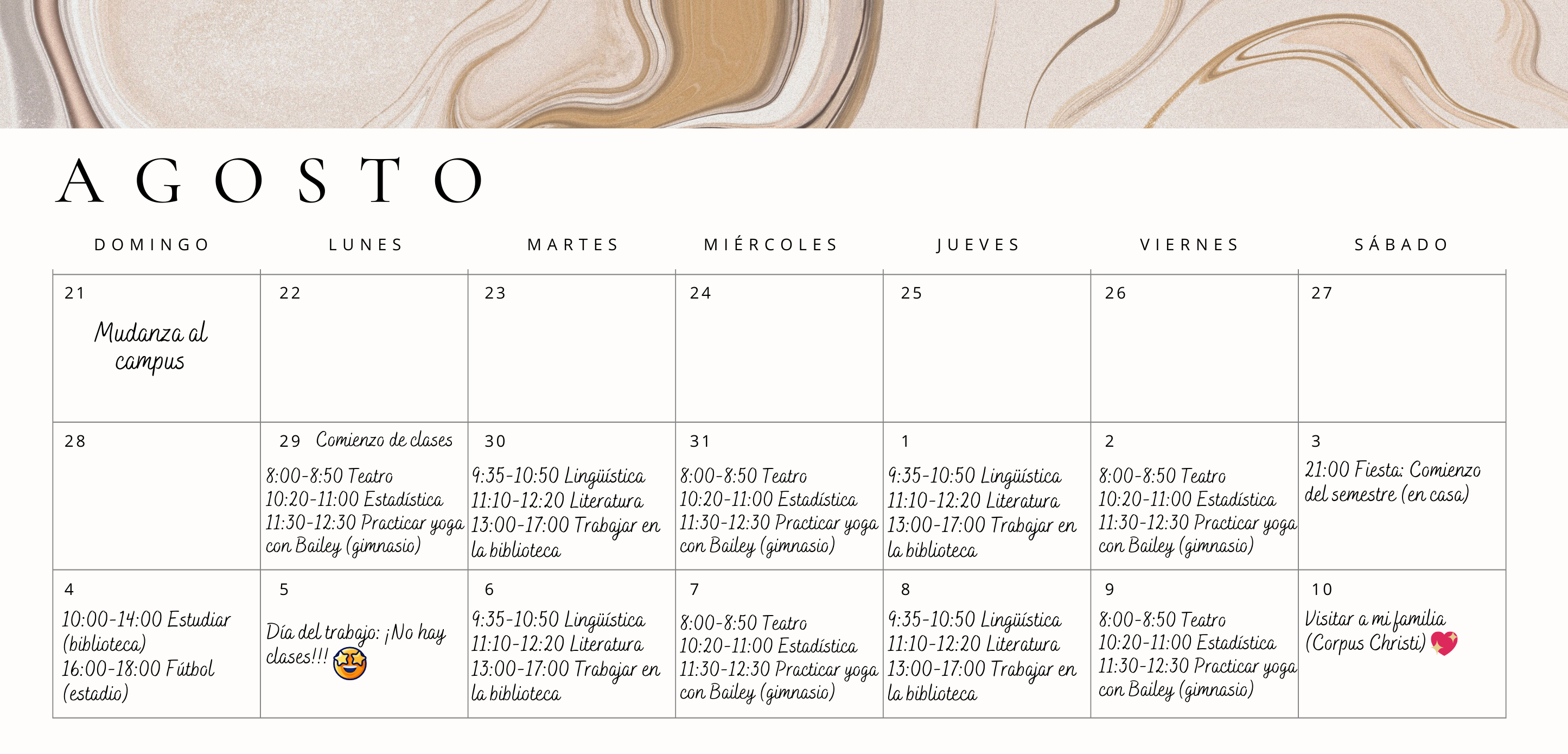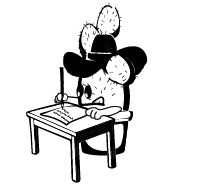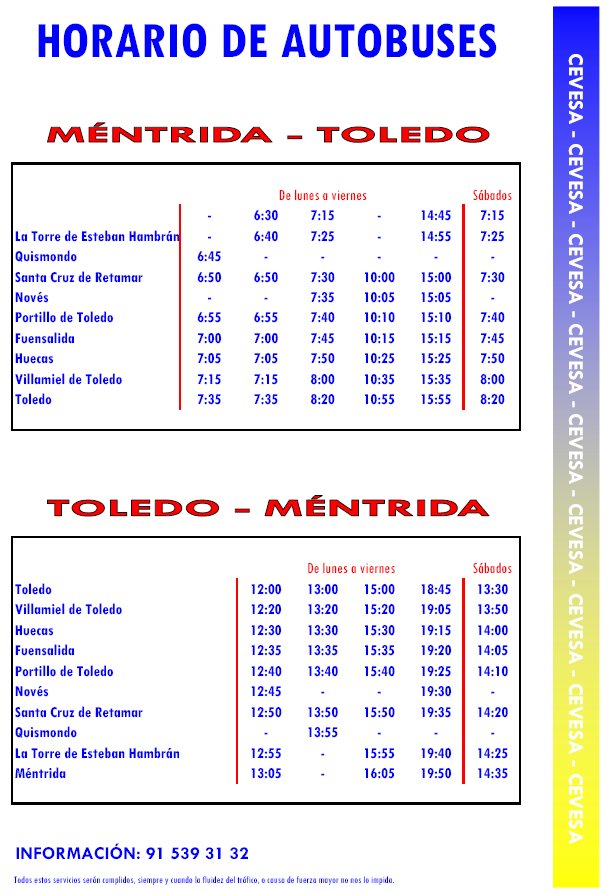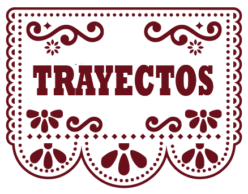 Uso y forma
Uso y forma
El horario de Carolina
Before organizing their party, Bailey and Carolina had to agree on a day. Bailey asked Carolina about her schedule. Listen to their dialogue and read the transcript below. Pay attention to the way in which they talk about dates and times in Spanish. What do you notice?

Bailey: Carolina: Bailey: Carolina: Bailey: Carolina: Bailey: Carolina: Bailey: Carolina:
¿Comprendiste?
1. First, we’re going to discover what you do in Spanish to express days and times.
-
- Have a look at the photo of Carolina’s schedule. What do you notice about the way in which she expresses time?
- What article do you use to express time? ¿El, la, los, or las?
- What word do we use to express at a certain time? Do you need that word when you just ask what time it is?
- How do you write days in Spanish? Is it the same as in English?
2. Now answer these questions taking both the photo and dialogue into account.
-
- ¿Qué días toma Carolina su clase de literatura?
- ¿Quién enseña la clase de lingüística?
- ¿A qué hora es la clase de estadística?
- ¿Cuándo viaja Carolina a Corpus Christi?
- ¿Cuándo estudia Carolina en la biblioteca? ¿Con quién estudia?
- ¿Qué hora es en el diálogo?
I. Los días de la semana
To ask for the date in Spanish, you can use ¿Cuál es la fecha? or ¿Qué día es hoy? (meaning What is the date? or What day is today?). To answer this question, you can say Hoy es day of the week and date of the month.
Hoy es jueves diecisiete (de agosto).
![]() ¡Ojo!
¡Ojo!
- The days of the week are NOT capitalized in Spanish.
- The masculine forms of the definite article (el lunes, los lunes) are used to refer to specific days. Notice that there is not a plural form for most days of the week. Exceptions: Saturday (el sábado, los sábados) and Sunday (el domingo, los domingos).
![]()
| Los días de la semana | |
| el lunes | Monday |
| el martes | Tuesday |
| el miércoles | Wednesday |
| el jueves | Thursday |
| el viernes | Friday |
| el sábado | Saturday |
| el domingo | Sunday |
II. ¿Qué hora es?
1. You use this question to ask for the time. As you saw in Carolina’s schedule, in the Spanish-speaking world (except for the United States), the 24-hour system is the most common. However, in informal settings (for example, with family or friends), the 12-hour system is preferred, and you use the expressions de la mañana (a.m.), de la tarde (early p.m.) y de la noche (late p.m.) to clarify what time of the day you are referring to. Have a look at these examples.
La recepción para los estudiantes nuevos es el jueves 23 a las diecinueve treinta horas (19:30). (Formal)
La recepción para los estudiantes es el jueves 23 a las siete y treinta / a las siete y media de la noche. (Informal)
2. To talk about time, you always use the verb ser. For all times of the day, you use son (Son las once de la noche.). Exceptions: You use es when: 1. You ask for the time (¿Qué hora es?), and 2. You express any time between 1:00 and 1:59 (e.g., Es la una y veinte.)
3. As you have seen, there are different ways to express on the quarter or half hour:
9:15 Son las nueve y cuarto. 9:45 Son las diez menos cuarto.
Son las nueve y quince. Son las nueve cuarenta y cinco.
9:30 Son las nueve y media.
Son las nueve y treinta.
These examples also show you that when you refer to minutes after the hour, you need the word y (e.g., Es la una y veinte [1:20]), and when you talk about minutes before the hour, you need the word menos (e.g., Son las dos menos veinte [1:40]).
III. ¿A qué hora es?
You use this question to ask at what time something takes place. As we saw in the dialogue, you need the word a to introduce the time phrase.
¿A qué hora es la clase de la Dra. Moyna? Es a las nueve y treinta y cinco de la mañana. / Es a las diez menos veinticinco de mañana.
IV. Algunas expresiones importantes
![]() Las expresiones de tiempo
Las expresiones de tiempo
| Las expresiones de tiempo | ||
| en punto | on the dot | La Profesora Dexter enseña su clase a las ocho en punto de la mañana. |
| a tiempo | on time | Carolina y Bailey llegan a la clase de lingüística a tiempo. |
| la medianoche | midnight | Efraín estudia hasta (until) la medianoche. |
| el mediodía | noon | Yo regreso a casa al mediodía. |
| todos los días | every day | ¿Tú tomas clases todos los días? |
| mañana | tomorrow | ¿Usted viaja a San Antonio mañana? |
The following video summarizes the information discussed in this section:
Now it’s time to use our new vocabulary and structures:
 ¡Manos a la obra!
¡Manos a la obra!
![]() Actividad 1-13. Tomamos el autobús. Remember Caroline, the student studying in Barcelona? She, a group of friends, and you, decide to visit the area of Toledo, Spain (google Toledo to find out where it is).
Actividad 1-13. Tomamos el autobús. Remember Caroline, the student studying in Barcelona? She, a group of friends, and you, decide to visit the area of Toledo, Spain (google Toledo to find out where it is).
Paso 1. You want to visit at least five different cities. Have a look at the following schedule, and choose five different towns to visit. Answer the following questions about each of them. En esta actividad, trabajas con tres o cuatro compañer@s.
- ¿A dónde viajan?
- ¿A qué hora toman el autobús?
- ¿A qué hora sale (leaves) el autobús de lunes a viernes?
- ¿A qué hora sale el autobús los sábados y domingos?

Paso 2. Busca fotos de las cuatro ciudades que tus compañer@s y tú visitan. ¿Dónde están estas ciudades? Busca un mapa de España, and be ready to show the rest of your classmates the result of your search. ¿Cómo son las ciudades? Describe las ciudades. Habla de dos o tres características.
![]() Actividad 1.14. Nuestros horarios. En esta actividad, trabajas con tres o cuatro compañer@s.
Actividad 1.14. Nuestros horarios. En esta actividad, trabajas con tres o cuatro compañer@s.
Paso 1. Taking Carolina’s schedule as an example, create your own. List the classes that you are taking in the same way she did, and include two extracurricular activities (e.g., a part time job, plans to study, etc.) during the week and on the weekend. Draw your calendar, and prepare to share it with your classmates.

Paso 2. Ahora con tres o cuatro compañer@s, compare your classes and activities. Find similaries. Talk about yourselves individually (yo forms), two of you (ellos/ellas), one of you in third person (él/ella), and you all (nosotros). Create a summary of your discussion to present to your classmates.
![]() ¡Conversemos!
¡Conversemos!
Paso 1. With a classmate, prepare a conversation. You will need to use the vocabulary and structures you learned in Módulo introductorio and in this module. Include the following information.
Estudiante 1. You are conducting a survey about students’ classes and preferred buildings on campus. Interview a volunteer about the classes that they take (Which classes? What time and what days do the classes take place? What are the classes like? Etc.). Also, ask the person about some of the buildings where they spend more time (pasar más tiempo) while on campus (Where are the buildings? What do they have inside? Etc.).
Estudiante 2. You are being interviewed about the classes that you are taking this semester and some of the buildings around campus. Answer the questions providing as much information as possible.
Paso 2. When you are done, work with another classmate. Reverse your roles.
Actividad 1-15. Mis clases. It has been a week since classes started. You are going to write an email to your high school Spanish teacher/university instructor telling him/her about the classes that you are taking. Tell him/her about your schedule (talk about times and days of the week), how many people are in each class, where you take them, and what the professors who teach them are like. Don’t forget to start and finish the email with a proper salutation and goodbye.
Estimado/a Prof. García:
¿Cómo está? Yo…
Click on the following button to continue using your new vocabulary and expressions.
Now it’s time to learn more about aspect of the Hispanic/Latinx communities in the United States:


